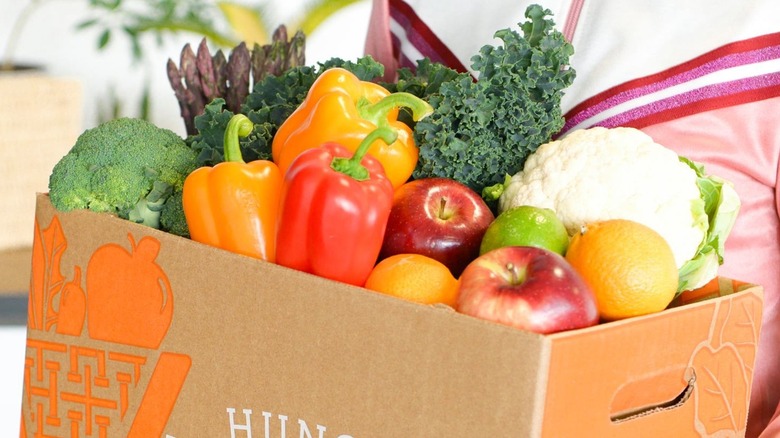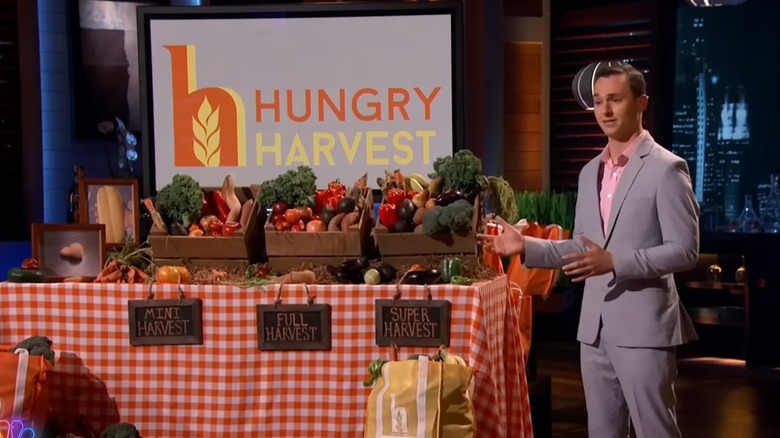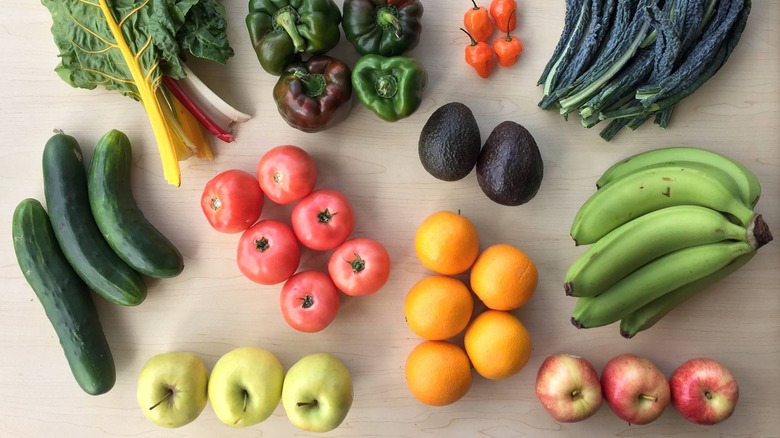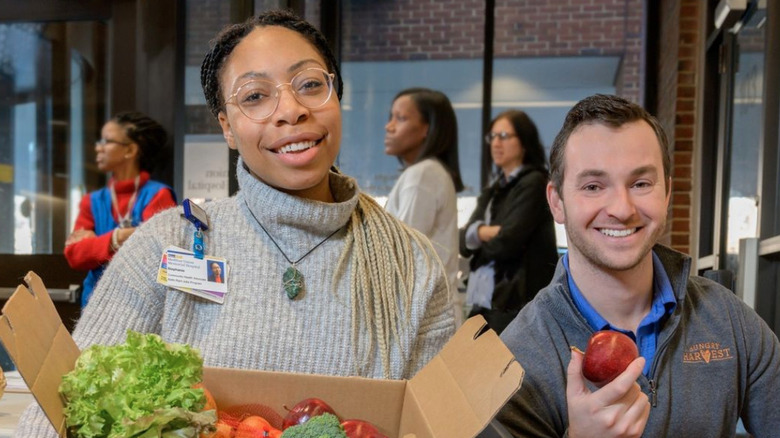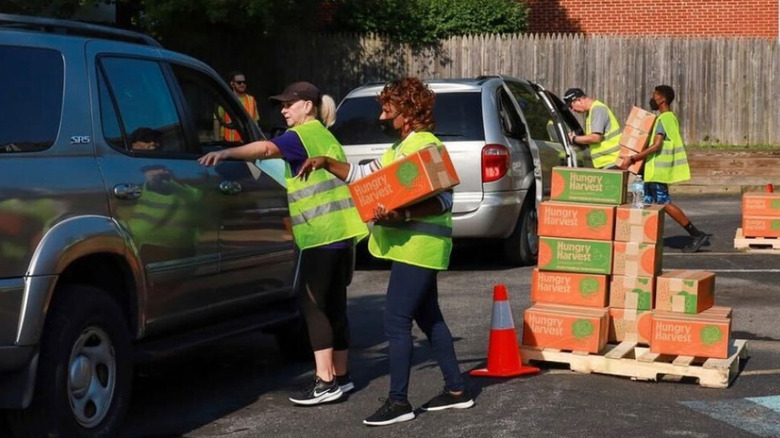What Happened To Hungry Harvest After Shark Tank?
For over a dozen seasons, ABC's reality hit "Shark Tank" has shown us hundreds of hopeful entrepreneurs whose products are sometimes so compellingly pitched that the Sharks fight over who can make the best offer. Hungry Harvest, which appeared on the show in Season 7, is a perfect example of a heart-warming story with a happy ending, though there were some bumps along the road. Barbara Corcoran said that, as she sat listening to him, she was thinking what a great guy he was but that he lacked the "grit and experience" necessary to be successful in business.
Hungry Harvest was founded by Evan Lutz in Baltimore in 2014. Lutz's family highly valued service to the community, which became part of his DNA. Fascinated by entrepreneurship, Lutz majored in business at the University of Maryland and became increasingly convinced that the best way to affect change was by scaling a business. He founded Hungry Harvest while still in college, inspired by a farmer who had trouble selling his funny-looking peppers. Lutz bought a portion of the farmer's produce and sold it on campus, never thinking his little business would really take off. After learning more about the troubled economics of food surpluses, he realized he had stumbled into something much larger than a mere farm stand and decided to take the plunge, turning it into a subscription farm share.
What happened to Hungry Harvest on Shark Tank?
In January 2016, Evan Lutz decided to take another risk and took to the Tank to introduce Hungry Harvest to the Sharks. Lutz explained how his company solves two problems in one. In the U.S., 30 to 40% of the food supply becomes food waste,including tons of perfectly usable fruits and vegetables that never reach consumers, either because they aren't pretty enough for the produce aisle or because of grower surpluses. There are practical ways of addressing food waste, but it's a thorny problem. Lutz takes advantage of the excess by making deals with farmers and wholesalers to buy their cache of ugly surplus produce at a discount, selling those fruits and veggies to consumers at below-grocery-store prices and then donating a portion to people in need. Shoppers who choose Hungry Harvest's subscription delivery service save 20 to 30% over what they would pay for "pretty" produce at the grocery store, and Hungry Harvest donates 1.2 pounds of produce for every purchased bag.
While the Sharks found Lutz's two-part mission to reduce food waste and hunger in America admirable, the concept really spoke to Robert Herjavec, who made Lutz an offer for double his asking price of $50,000 for 5% equity. Lutz initially waited to hear other Sharks' offers, but when Herjavec grew impatient with Kevin O'Leary's drawn-out evaluation, Herjavec pressured Lutz to decide. Lutz accepted his offer of $100,000 for a 10% stake.
Healthy Harvest After Shark Tank
So what did Hungry Harvest accomplish with that $100,000 investment? From the looks of it, quite a bit. According to a press release, Hungry Harvest thought that partnering with a Shark would help expand the company's system. At the time, Evan Lutz was only operating in the Washington D.C. and Baltimore areas, but he hoped that the Sharks could help take his deliveries nationwide. While Lutz has not yet fulfilled that dream, the business has expanded significantly. After the appearance on Shark Tank, Hungry Harvest moved into markets throughout the Mid-Atlantic in New Jersey, Maryland, Delaware, and the Philadelphia and Detroit metro areas and also opened shop in select areas in Florida and North Carolina.
However, the Sharks weren't the only factors in Hungry Harvest's success. The pandemic precipitated a surge in food subscription services that provided an additional boost to the young company. Hungry Harvest raised almost $14 million in 2020 to develop and expand its business model, demonstrating that its efforts at limiting food waste weren't necessarily at odds with market realities. A significant number of investors were on board with the company's dual mission of profit and philanthropy, and the company has continued to expand in the regions it serves. For its food donations, Hungry Harvest generally pairs with a local partner, strengthening relationships within the community in the process.
Hungry Harvest continues to see healthy growth
The company also expanded its offerings beyond delivering produce. To add convenience for its customers, the subscription service now offers additional selections from its Marketplace, including branded pantry staples, kombucha, a selection of branded ready-to-eat veggie meals, and select name-brand grocery items, including a wide assortment of plant-based proteins. Hungry Harvest appears to have repositioned itself as a vegan and vegetarian destination.
Despite recent and dramatic food inflation (the worst in 40 years), the cost of the produce delivery packages has not changed much since they first appeared on "Shark Tank" in 2016. A "Full Harvest" Box is priced at $27, providing an abundance of produce at an affordable price. The company has also developed its personnel infrastructure, growing from four full-time employees in 2016 to over 50 employees in 2018, and those numbers are growing. As of 2023, 57 people work for Hungry Harvest. In 2021, the delivery service saw annual profits of $4 million, and in 2023, that had risen to over $14 million annually — not bad for a project some of the Sharks felt was too altruistic to succeed.
What's next for Evan Lutz and Hungry Harvest?
These days, Hungry Harvest looks to grow in new and healthy ways to bolster its bottom line and help Americans at risk. This year, it became possible for the first time for recipients to use Medicaid funds to pay for produce if doctors deem that their health would benefit from an improved diet. Many Americans have been diagnosed with diseases that could be partially treated by better nutrition, and increasing vegetable consumption is an ideal way to do so.
Lutz and his team seek to raise $5 million to boost growth as they prepare to expand their supply to create "prescription boxes" of produce — a natural outgrowth for Hungry Harvest's dual mission. Determined to bring fresh fruit and vegetables to people with limited incomes, Hungry Harvest has always seen ending food insecurity as its mission. This new opportunity would provide federal money to support Hungry Harvest's philanthropic goals while providing a considerable profit boost.
